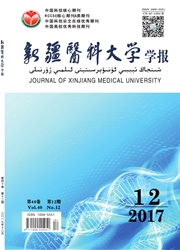

 中文摘要:
中文摘要:
目的:探寻中医学六气与实际气候变化的对应关系,揭示西北燥证外感病因之六淫构成,为该证的病机与防治研究提供依据。方法:采集新疆及全国相关气候指标数据,运用因子分析淬取公因子,拟合其负荷结构并根据中医病因理论加以六气赋名,计算各地六气气化值,结合西北燥证流行病学调查资料,分析六淫与西北燥证的病因亲疏关系。结果:南疆燥气气化值最高,北疆、甘肃、青藏、内蒙古、宁夏等区次之,两广华南、浙闽华东南、川渝西南等区最低;湿气气化值恰与之相反;暑气、寒气、火气、风气气化值则分别以两广浙闽、东北北疆、南疆、山东为高。和田、哈密、伊犁、鸟鲁木齐之燥气气化标准值居六气之首;吐鲁番火居第一,燥居第二;新疆五地湿气:暑气殊少;相反,乐山、上海湿一而暑二,燥气最低。同时,西北燥证罹患率又与燥气气化值呈显著正相关,和田燥气值最盛,其燥证罹患率亦最高。结论:运用因子分析探讨六淫与气候因素的关系具有明显优势;新疆及西北地区燥气最盛;西北燥证外感病因首推燥邪,次责火邪,亦关乎风寒二邪。
 英文摘要:
英文摘要:
Objective.. To explore the correlations between six climatic conditions of TCM and real variation of climate, to reveal the components of six climatic pathogenic factors of Northwest Dryness Syndrome (NDS). Thus offering evidence for the research of pathogenesis and prevention of NDS. Methods. To collect related indexes climatically of Xinjiang and related areas in the country, then select some kinds of common factors by means of factors analysis methods, forming their compound structure, named six climatic conditions according to the theories of TCM. so we can figure out the value of qihua of six climatic conditions in different regions, combined with epidemiological investigation data, analyzing the priority between six climatic pathogenic factors and NDS's etiological factors. Results: The six climatic conditions were wind qi, cold qi, summer-heat qi, dampness qi, dryness qi and fire qi. There was an apparent difference at the value of qihua of six climatic conditions in different regions, the prevalence rate of NDS was positively correlated with the value of dryness qi. Which was significantly increased in Hotan Xinjiang, so the prevalence rate of NDS in Hotan Was the highest. Conclusion: It is dominant to explore the relationship between six climatic pathogenic factors and climatic factors by means of factors analysis methods, the exogenous pathogenic factors of Northwest Dryness Syndrome: first is exogenous dryness, second is exogenous fire, also connected with exogenous wind and cold.
 同期刊论文项目
同期刊论文项目
 同项目期刊论文
同项目期刊论文
 期刊信息
期刊信息
